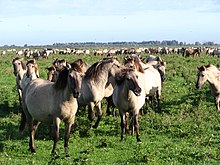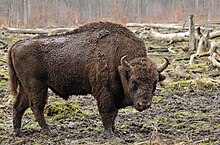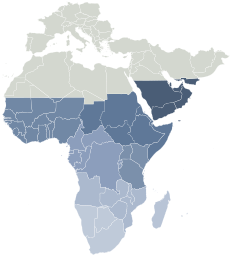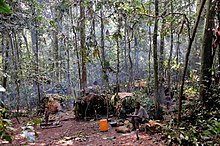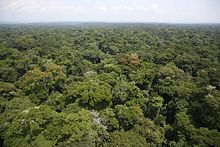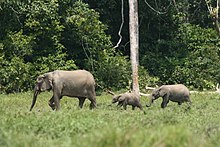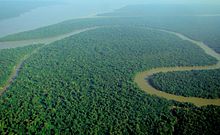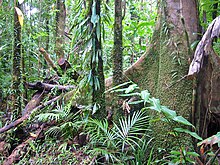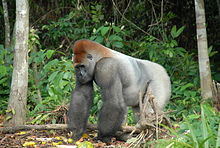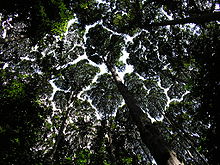A wildlife crossing structure on the Trans-Canada Highway in Banff National Park,
Canada. Wildlife-friendly overpasses and underpasses have helped
restore connectivity in the landscape for wolves, bears, elk, and other
species.
Rewilding is large-scale conservation aimed at restoring and
protecting natural processes and core wilderness areas, providing
connectivity between such areas, and protecting or reintroducing apex predators and keystone species.
Rewilding projects may require ecological restoration or wilderness
engineering, particularly to restore connectivity between fragmented
protected areas, and reintroduction of predators and keystone species
where extirpated. The ultimate goal of rewilding efforts is to create
ecosystems requiring passive management by limiting human control of
ecosystems. Successful long term rewilding projects should be considered
to have little to no human-based ecological management, as successful
reintroduction of keystone species creates a self-regulatory and self-sustaining stable ecosystem, with near pre-human levels of biodiversity.
Origin
The word rewilding was coined by conservationist and activist Dave Foreman, one of the founders of the group Earth First! who went on to help establish both the Wildlands Project (now the Wildlands Network) and the Rewilding Institute. The term first occurred in print in 1990 and was refined by conservation biologists Michael Soulé and Reed Noss in a paper published in 1998. According to Soulé and Noss, rewilding is a conservation method based on "cores, corridors, and carnivores." The concepts of cores, corridors, and carnivores were developed further in 1999. Dave Foreman subsequently wrote the first full-length exegesis of rewilding as a conservation strategy.
More recently, anthropologist Layla AbdelRahim
offered a new definition of rewilding: "Wilderness is ... a cumulative
topos of diversity, movement, and chaos, while wildness is a
characteristic that refers to socio-environmental relationships".
According to her, because civilization is a constantly growing
enterprise, it has completely colonized the earth and imperiled life on
the planet. Therefore, rewilding can start only with a revolution in the
anthropology that constructs the human as predator.
History
Rewilding was developed as a method to preserve functional ecosystems and reduce biodiversity loss, incorporating research in island biogeography and the ecological role of large carnivores. In 1967, The Theory of Island Biogeography by Robert H. MacArthur and Edward O. Wilson
established the importance of considering the size and isolation of
wildlife conservation areas, stating that protected areas remained
vulnerable to extinctions if small and isolated. In 1987, William D. Newmark's study of extinctions in national parks in North America added weight to the theory. The publications intensified debates on conservation approaches. With the creation of the Society for Conservation Biology in 1985, conservationists began to focus on reducing habitat loss and fragmentation.
Elements required for successful rewilding
Rewilding
is important on land but perhaps more important is where land meets the
water. Dam removal is the first of many steps in the process of
rewilding in the riverine ecosystems. However, there are problems that
should be addressed before, during, and after the dam removal. The
problems are the sediments that have built up and wash out filling in
spawning beds should be controlled and directed, then eliminating any
and all clear cutting of trees near river banks as it raises the
temperature of the water, and stopping industrial discharges for obvious
reasons.
At 90 different dam sites it has been confirmed that after a dam is
built the ecosystem does rebound. However, the trend will eventually
slow, stop and in some cases decline. This is often due to anthropogenic
chemical, light, and noise pollution as the large bodies of water draw
human activity and recreation. Nemecek writes that, "researchers found
that the number of species within any given area dropped by 50%.
Lastly, food sources for native animals and fish need to be introduced
so as to improve the long-term sustainability of native species and
curtail and/or eliminate the introduction of invasive species.
Key species
The
beaver is by far the most important element of a riverine ecosystem.
Firstly, the dams they build create micro ecosystems that can be used as
spawning beds for salmon and collect invertebrates for the salmon fry
to feed on. The dams, again built by beavers, create wetlands for plant,
insect, and bird life. Specific trees, alder, birch, cottonwood, and
willow are important to beaver's diets and must be encouraged to grow in
areas accessible by the animals. In terms of seeding the birds can do
much of the rest. These animals have a trickle down effect as they create ecosystems that have the potential to grow exponentially.
Major rewilding projects
Between 800 and 1150 wild koniks live in the Oostvaardersplassen, a 56 km² rewilding project in the Netherlands
Both grassroots groups and major international conservation organizations have incorporated rewilding into projects to protect and restore large-scale core wilderness areas, corridors
(or connectivity) between them, and apex predators, carnivores, or
keystone species (species which interact strongly with the environment,
such as elephant and beaver). Projects include the Yellowstone to Yukon Conservation Initiative in North America (also known as Y2Y) and the European Green Belt, built along the former Iron Curtain; transboundary projects, including those in southern Africa funded by the Peace Parks Foundation;
community-conservation projects, such as the wildlife conservancies of
Namibia and Kenya; and projects organized around ecological restoration,
including Gondwana Link, regrowing native bush in a hotspot of endemism in southwest Australia, and the Area de Conservacion Guanacaste, restoring dry tropical forest and rainforest in Costa Rica. European Wildlife, established in 2008, advocates the establishment of a European Centre of Biodiversity at the German–Austrian–Czech borders.
In North America, another major project aims to restore the prairie grasslands of the Great Plains. The American Prairie Foundation is reintroducing bison on private land in the Missouri Breaks region of north-central Montana, with the goal of creating a prairie preserve larger than Yellowstone National Park.
Dam removal has led to the restoration of many river systems in the
Pacific Northwest. This has been done in an effort to restore salmon
populations specifically but with other species in mind. "These dam
removals provide perhaps the best example of large-scale environmental
remediation in the twenty-first century. This restoration, however, has
occurred on a case-by-case basis, without a comprehensive plan. The
result has been to put into motion ongoing rehabilitation efforts in
four distinct river basins: the Elwha and White Salmon in Washington and
the Sandy and Rogue in Oregon."
An organization called Rewilding Australia
has formed which intends to restore various marsupials and other
Australian animals which have been extirpated from the mainland, such as
Eastern quolls and Tasmanian devils.
Projects in Europe
European bison (Bison bonasus);
Europe's largest living land animal. The European bison was driven to
extinction in the wild in 1927; in the mid-20th century and early 21st
century, the bison has been re-introduced into the wild. The bison
stands nearly 2 metres tall and weighs as much as 1,000 kg.
In the 1980s, the Dutch government began introducing proxy species in the Oostvaardersplassen nature reserve in order to recreate a grassland ecology.
Though not explicitly referred to as rewilding, nevertheless many of
the goals and intentions of the project were in line with those of
rewilding. The reserve is considered somewhat controversial due to the
lack of predators and other native megafauna such as wolves, bears, lynx, elk, boar, and wisent.
Since the 1980's, 8.5 million trees have been planted in the United Kingdom in an area of the midlands around the villages of Moira and Donisthorpe, close to Leicester. The area is called The National Forest. Another, larger, reforestation project, aiming to plant 50 million trees is beginning in South Yorkshire, called The Northern Forest. Despite this, the UK government has been criticised for not achieving its tree planting goals. The Knepp Estate and Roy Dennis Wildlife Foundation have overseen reintroductions of extinct bird species in the UK.
In 2011, the 'Rewilding Europe' initiative was established with the aim of rewilding 1 million hectares of land in ten areas including the western Iberian Peninsula, Velebit, the Carpathians and the Danube delta by 2020, mostly abandoned farmland among other identified candidate site. The present project considers only species that are still present in Europe, such as the Iberian lynx, Eurasian lynx, wolf, European jackal, Brown bear, chamois, Spanish ibex, European bison, red deer, griffon vulture, cinereous vulture, Egyptian vulture, Great white pelican and horned viper, along with a few primitive breeds of domestic horse and cattle as proxies for the extinct tarpan and aurochs. Since 2012, Rewilding Europe is heavily involved in the Tauros Programme, which seeks to recreate the phenotype of the aurochs, the wild ancestors of domestic cattle by selectively breeding existing breeds of cattle. Many projects also employ domestic water buffalo as a grazing proxy for the extinct European water buffalo.Reviving Europe.
Historic range of the European bison.
Maximum Holocene range
Range during the high middle ages
Relict 20th century populations
In 2010 and 2011, an unrelated initiative in the village of San Cebrián de Mudá (190 inhabitants) in Palencia, northern Spain released 18 European bisons (a species extinct in Spain since the Middle Ages) in a natural area already inhabited by roe deer, wild boar, red fox and grey wolf, as part of the creation of a 240-hectare "Quaternary Park". Three Przewalski horses from a breeding center in Le Villaret, France were added to the park in October 2012. Onagers and "aurochs" were planned to follow.
On 11 April 2013, eight European bison (one male, five females
and two calves) were released into the wild in the Bad Berleburg region
of Germany, after 300 years of absence from the region.
In 2014 the German government built a 3 km road tunnel to remove an Autobahn from the Leutratal und Cospoth nature reserve.
In 2016 and 2018, the True Nature Foundation reintroduced in
total 7 European bison of the Lowland-Caucasian breeding line in Anciles
Wildlife Reserve in the Parque Regional de Picos de Europa in the Cantabrian mountains in northern Spain.
Pleistocene rewilding
Pleistocene rewilding was proposed by the Brazilian ecologist Mauro Galetti in 2004.
He suggested the introduction of elephants (and other proxies of
extinct megafauna) from circuses and zoos to private lands in the
Brazilian cerrado. In 2005, stating that much of the original megafauna
of North America—including mammoths, ground sloths, and sabre-toothed
cats—became extinct after the arrival of humans, Paul S. Martin
proposed restoring the ecological balance by replacing them with
species which have similar ecological roles, such as Asian or African
elephants.
A reserve now exists for formerly captive elephants on the Brazilian Cerrado.
A controversial 2005 editorial in Nature,
signed by a number of conservation biologists, took up the argument,
urging that elephants, lions, and cheetahs could be reintroduced in
protected areas in the Great Plains. The Bolson tortoise,
discovered in 1959 in Durango, Mexico, was the first species proposed
for this restoration effort, and in 2006 the species was reintroduced to
two ranches in New Mexico owned by media mogul Ted Turner. Other proposed species include various camelids, equids, and peccaries.
In 1988, researcher Sergey A. Zimov established the Pleistocene Park
in northeastern Siberia to test the possibility of restoring a full
range of grazers and predators, with the aim of recreating an ecosystem
similar to the one in which mammoths lived.
Yakutian horses, reindeer, snow sheep, elk, yak and moose were
reintroduced, and reintroduction is also planned for bactrian camels,
red deer, and Siberian tigers. The wood bison, a close relative of the
ancient bison that died out in Siberia 1000 or 2000 years ago, is also
an important species for the ecology of Siberia. In 2006, 30 bison
calves were flown from Edmonton, Alberta to Yakutsk and placed in the
government-run reserve of Ust'-Buotama. This project remains
controversial — a letter published in Conservation Biology
accused the Pleistocene camp of promoting "Frankenstein ecosystems,"
stating that "the biggest problem is not the possibility of failing to
restore lost interactions, but rather the risk of getting new, unwanted
interactions instead."
The authors proposed that—rather than trying to restore a lost
megafauna—conservationists should dedicate themselves to restoring
existing species to their original habitats.

